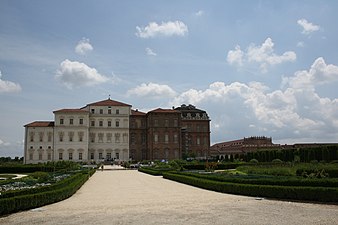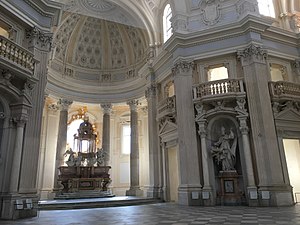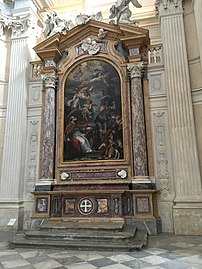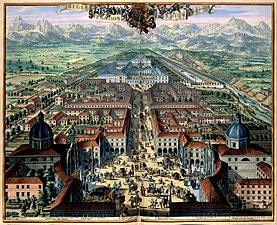Palace of Venaria
| Palace of Venaria | |
|---|---|
Reggia di Venaria Reale | |
 View of the Palace | |
 Interactive fullscreen map | |
| General information | |
| Location | Venaria Reale, Metropolitan City of Turin, Italy |
| Coordinates | 45°8′8.99″N 7°37′24.67″E / 45.1358306°N 7.6235194°E |
| Technical details | |
| Floor area | 80,000 m2 (861,112 ft2)[1] |
| Website | |
| www | |
Europe | |
The Palace of Venaria (Italian: Reggia di Venaria Reale) is a former royal residence and gardens located in
The Palace was designed and built from 1675 by
It is noted for its monumental architecture and Baroque interiors by Filippo Juvarra, including the Galleria Grande and its marble decorations, the chapel of Saint Uberto, and its extensive gardens. It received 1,048,857 visitors in 2017, making it the sixth most visited museum in Italy.[2]
History
17th century structure

In 1658 Charles Emmanuel commissioned the project of the palace and the new town built around to architect
Castellamonte also built the loggia and theater in the upper garden (1666), the square in front of the palace (1667), the twin facades of the churches in the town square (1669), the citroneria and the fountain of Hercules, the avenue of the fountain of Hercules (1671), the temple of Diana in the gardens (1673), the porticos of the central street of the town (1679). The entire complex was tied together by the straight axis that cut across the town, reached the heart of palace, followed the canal and arrived to the fountain of Hercules and finally the temple of Diana in the gardens.
18th century additions
After the French destroyed some buildings on 1 October 1693 (fighting the Savoys as part of the
In 1739,
Military use and abandonment
In 1792, the Kingdom of Sardinia and the other states of the Savoy Crown joined the
Because of the heavy damage sustained during the French occupation, once Napoleon was defeated and the Kingdom of Sardinia restored, the palace of Venaria did not revert to its previous role as royal residence, but became a Royal Military Domain (Regio Demanio Militare). The decors and furnishing that could be salvaged were transferred to the other palaces and castles of the Savoy court, and the role of royal summer residence was taken up by the castle of Racconigi, that of Stupinigi, and that of Agliè.[7]
During its role as a military structure, which included being part of the Demanio Militare between 1851 and 1943, the complex was used Italian Army. iI housed the Field Artillery Regiment "a Cavallo", the Regia Scuola Militare (today Scuola di cavalleria dell'Esercito Italiano), and the 5th Field Artillery Regiment from 1850 to 1943. In the early 1900s the military started slowly abandoning the site, and the property gradually was transferred to the Ministry of Culture, starting in 1936 with the Chapel.
Restoration
Once the military garrison was removed, the palace became prey to vandalism and continued on a slow and inexorable abandon. Given the lack of funds for the site, the interventions of the Ministry of Culture were minimal and essential and aimed at the preservation of the structural integrity of the buildings. A small scale restoration of the Chapel was undertaken in the 1940s.[9]
In 1961, in occasion of the celebration of the 100th Anniversary of the Unification of Italy, the Great Gallery and the Hall of Diana were briefly restored, albeit in a mostly scenographic manner.[7] In the 1960s a group of Venariese citizens gave life to the Coordinamento Venariese per la Tutela e Restauro del Castello (Venariese Coordination for the Protection and Restoration of the Castle), which started some limited work to restore and highlight the decaying palace.
Starting in the 1980s, funds from the FIO (fondi di investimento occupazionale) were employed for early work of redevelopment, restoration and enhancement aimed at raising public awareness.
On 5 December 1996, the Minister for Culture
In 1997 it was added to the
The complex was open for tourism from 13 October 2007, and has since become a major tourist destination and space for exhibitions and events. It received 1,048,857 visitors in 2017, making it the sixth most visited
In recent years, it has served as a filming location for several movies, including The King's Man and Miss Marx.[14] The palace hosted the "Turquoise Carpet" and Opening Ceremony events for the Eurovision Song Contest 2022.[15]
Architecture
The Palace

The palace is made up of two distinct wings: the original 17th century Palace of Diana, covered in white plaster, and the later 18th-century addition, with exposed brickwork. The entrance of the palace leads into the Cour d'honneur ("Honour Court"), which once housed a fountain with a deer.
Palace of Diana
The Palace of Diana is the core of the complex and the oldest section of the palace. It was built between 1658 and 1663 under the direction of Amedeo di Castellamonte. The main facade, covered with plaster and featuring cornucopias, shells and fruits, is connected on the right by section with the 18th-century wing. The facade facing the Honor Court presents a loggia flanked by an arched entryway on its right. Originally, there was a twin archway on the left of the loggia, but it was removed during Garove's reworking.
The
18th century wing
The two pavilion date to the Michelangelo Garove period (1669–1713) and are covered with multicolor pentagonal tiles in ceramics, which are united by a large gallery, known as Grand Gallery (Galleria Grande). The centerpiece of the 18th-century wing is the Galleria Grande (Grand Gallery), which is stucco decorations, 44 arched windows, and black and white tiled floor.[16] The interiors originally housed a large collection of stuccos, statues, paintings (according to Amedeo di Castellamonte, up to 8,000) from some of the court artists of the times, such as Vittorio Amedeo Cignaroli, Pietro Domenico Olivero and Bernardino Quadri.
Gardens
The original gardens of the residence have now totally disappeared, since French troops turned them into training grounds. Earlier drawings show an Italian garden with three terraces connected by elaborate stairways and architectural features such as a clock tower in the first court, the fountain of Hercules, a theatre and parterres.
Recent works have recreated a park in modern style, exhibiting modern works by Giuseppe Penone, including a fake 12 m-high cedar housing the thermic discharges of the palace.
Juvarra Stables and Citroneria
The
Church of Sant'Uberto
After the death of Garove (1713), Juvarra was commissioned by
Inside, the
-
The exterior and main façade of the church
-
The Trompe-l'œil mimicking the dome
-
Interior of the chapel
-
The central space
Gallery
-
The Court's departure for the hunt from the Venaria Reale by Melchior Hamers, 1668
-
The Belvedere and the Garove Pavilion
-
Galleria Grande (erroneously known as "Diana's Gallery")
-
View of the town and the palace in the late 17th century)
See also
- List of Baroque residences
- Lux (album) – a 2012 album by Brian Eno which was initially a soundtrack for the Grand Gallery
Sources
- Merlini, Carlo. Ambienti e Figure di Torino Vecchia. Turin: Tipografia Rattero.
- Vinardi, Maria Grazia (2022). "La Venaria Reale". In Ricuperati, Giuseppe (ed.). Storia di Torino (in Italian). ISBN 9788806162115.
References
- ^ "History in brief". 8 November 2017.
- ^ a b "Musei, monumenti e aree archeologiche statali" [State museums, monuments and archaeological areas] (PDF). ilsole24ore.it (in Italian). 5 January 2017. Retrieved 5 March 2017.
- ISBN 9788806162115.
- ^ Cornaglia, Paolo. "La Reggia di Diana" (PDF). Reggia di Venaria. Retrieved 2023-04-11.
- ^ http://www.21-style.com, MuseoTorino,Comune di Torino,Direzione Musei,Assessorato alla Cultura e al 150° dell’Unità d’Italia, 21Style. "Venaria Reale, Reggia di Diana - MuseoTorino". www.museotorino.it (in Italian). Retrieved 2023-04-11.
{{cite web}}: External link in|last= - ^ "History in brief". La Venaria Reale. 2017-11-08. Retrieved 2023-04-07.
- ^ ISSN 0362-4331. Retrieved 26 January 2022.
- ISBN 978-88-7062-779-4.
- ^ "Restauro". La Venaria Reale (in Italian). 2017-09-14. Retrieved 2023-04-10.
- ^ "Restauro". La Venaria Reale (in Italian). 2017-09-14. Retrieved 2023-04-10.
- ^ ISSN 0362-4331. Retrieved 26 January 2022.
- ^ "I giardini della reggia di Venaria: ecco il parco più bello d'Italia". la Repubblica (in Italian). 2019-10-03. Retrieved 2022-01-26.
- ^ "Dolce Stil Novo alla Reggia – Venaria Reale - a MICHELIN Guide Restaurant". MICHELIN Guide. Retrieved 2022-01-26.
- ^ "Know About The King's Man Filming Locations | Readsme". 2021-12-21. Retrieved 2022-01-26.
- ^ "Eurovision 2022: All the news and looks from the Turin Turquoise Carpet". Eurovision.tv. 2022-05-08. Retrieved 2022-05-09.
- ^ a b "Storia della Reggia di Venaria Reale: tutto ciò che c'è da sapere". Mole24 (in Italian). Retrieved 2022-01-26.
- ^ "Bucintoro reale dei Savoia". La Venaria Reale (in Italian). 2018-07-23. Retrieved 2022-01-26.
- ^ "The Juvarra Stables". La Venaria Reale. 2017-11-15. Retrieved 2022-01-26.
- ^ a b "The Church of St. Hubert". La Venaria Reale. 2017-11-15. Retrieved 2022-01-26.
- ^ a b "Chiesa di Sant'Uberto". Museo Torino (in Italian). Museo Torino, Comune di Torino, Direzione Musei, Assessorato alla Cultura e al 150° dell'Unità d'Italia, 21Style. Retrieved 26 January 2022.
- ^ "La Venaria Reale - Recensioni - Arte - Repubblica.it". www.repubblica.it. Retrieved 2022-01-26.
External links
- Official website (in English)
- A.V.T.A. – Royal Palace of Venaria (en)
- Martinelli, Nicole (16 December 2007). "A Pleasure Palace Rises Again". The New York Times. ISSN 0362-4331. Retrieved 26 January 2022.
- Virtual tour of the Palace of Venaria provided by Google Arts & Culture
 Media related to Reggia (Venaria Reale) at Wikimedia Commons
Media related to Reggia (Venaria Reale) at Wikimedia Commons













